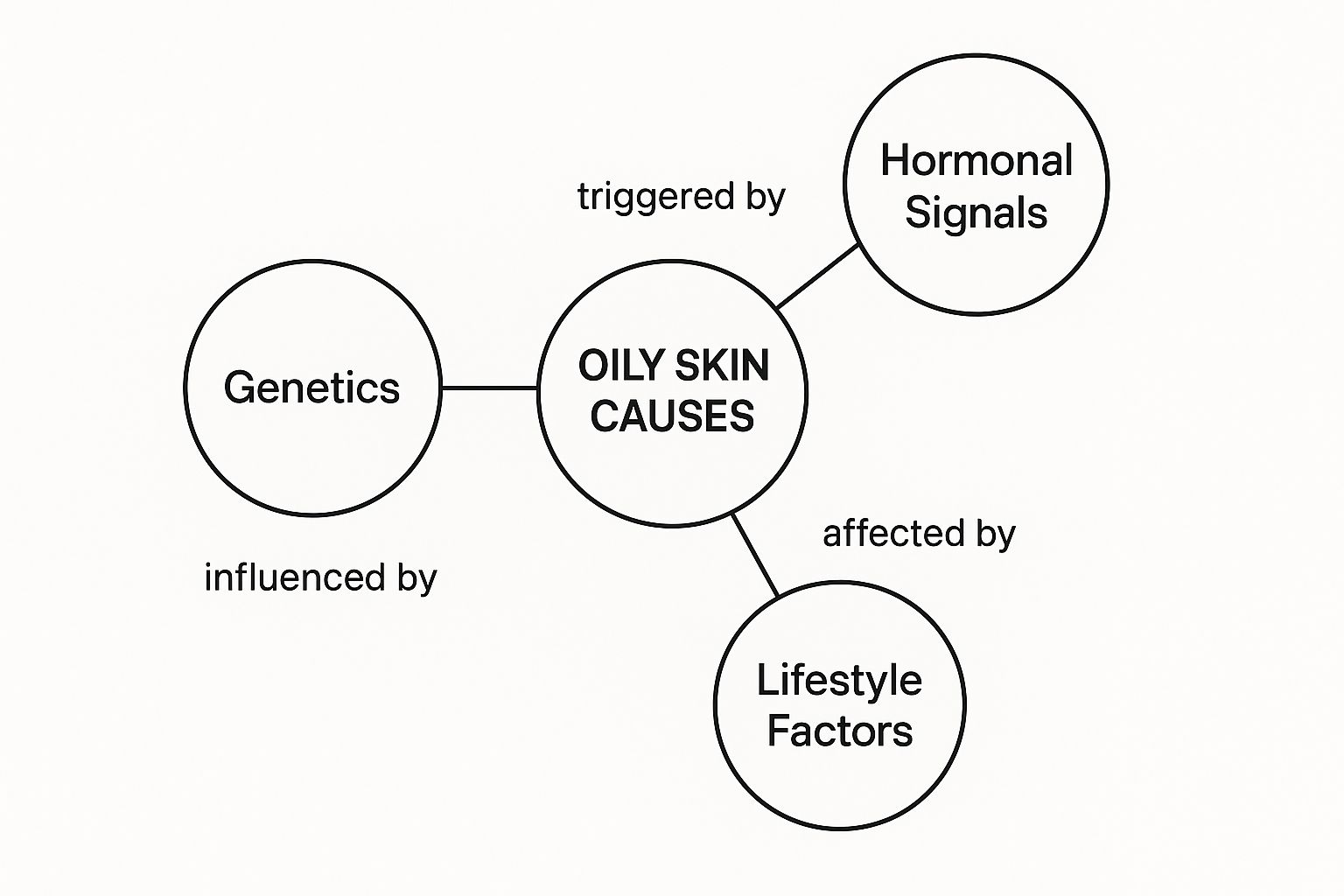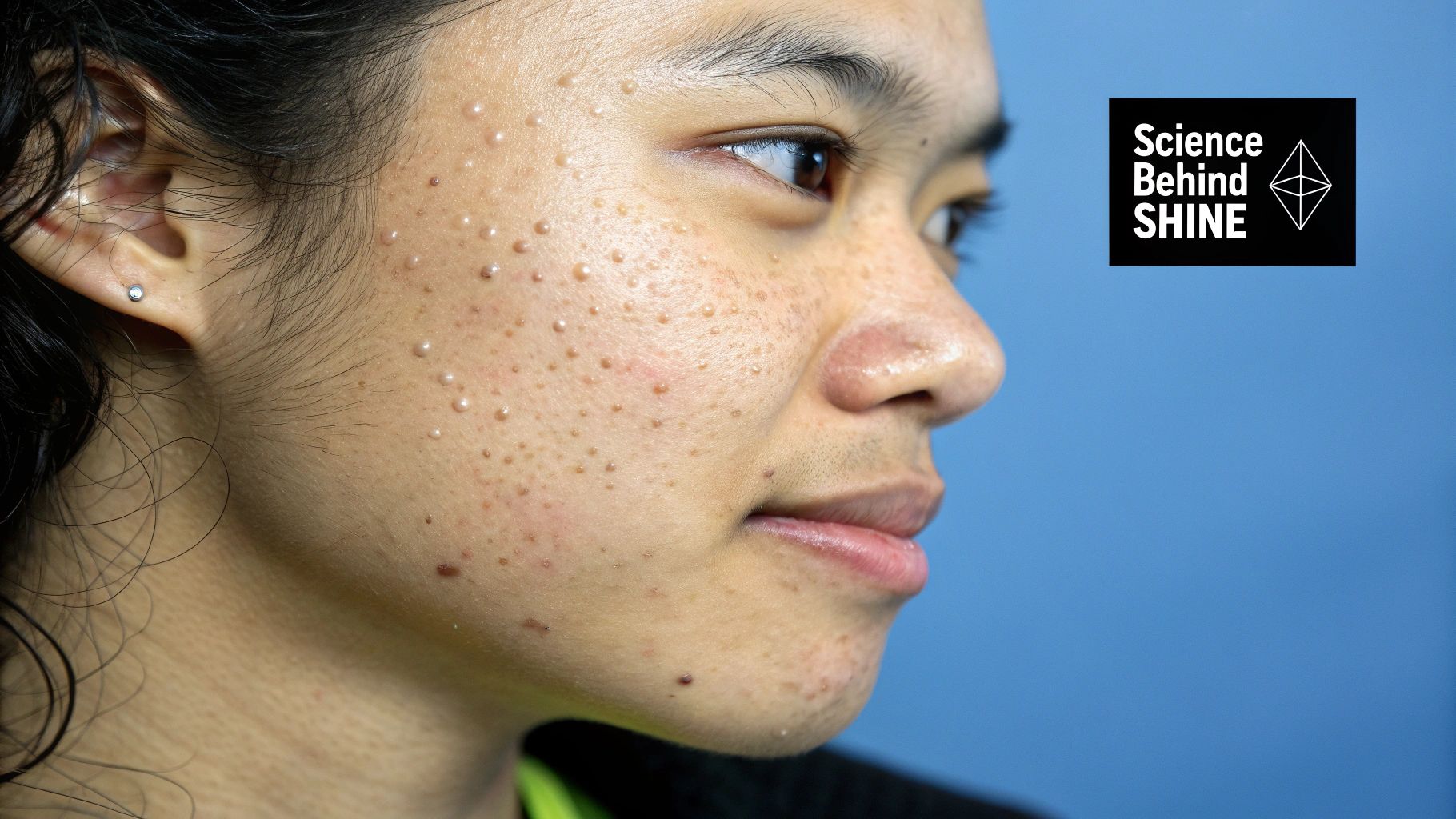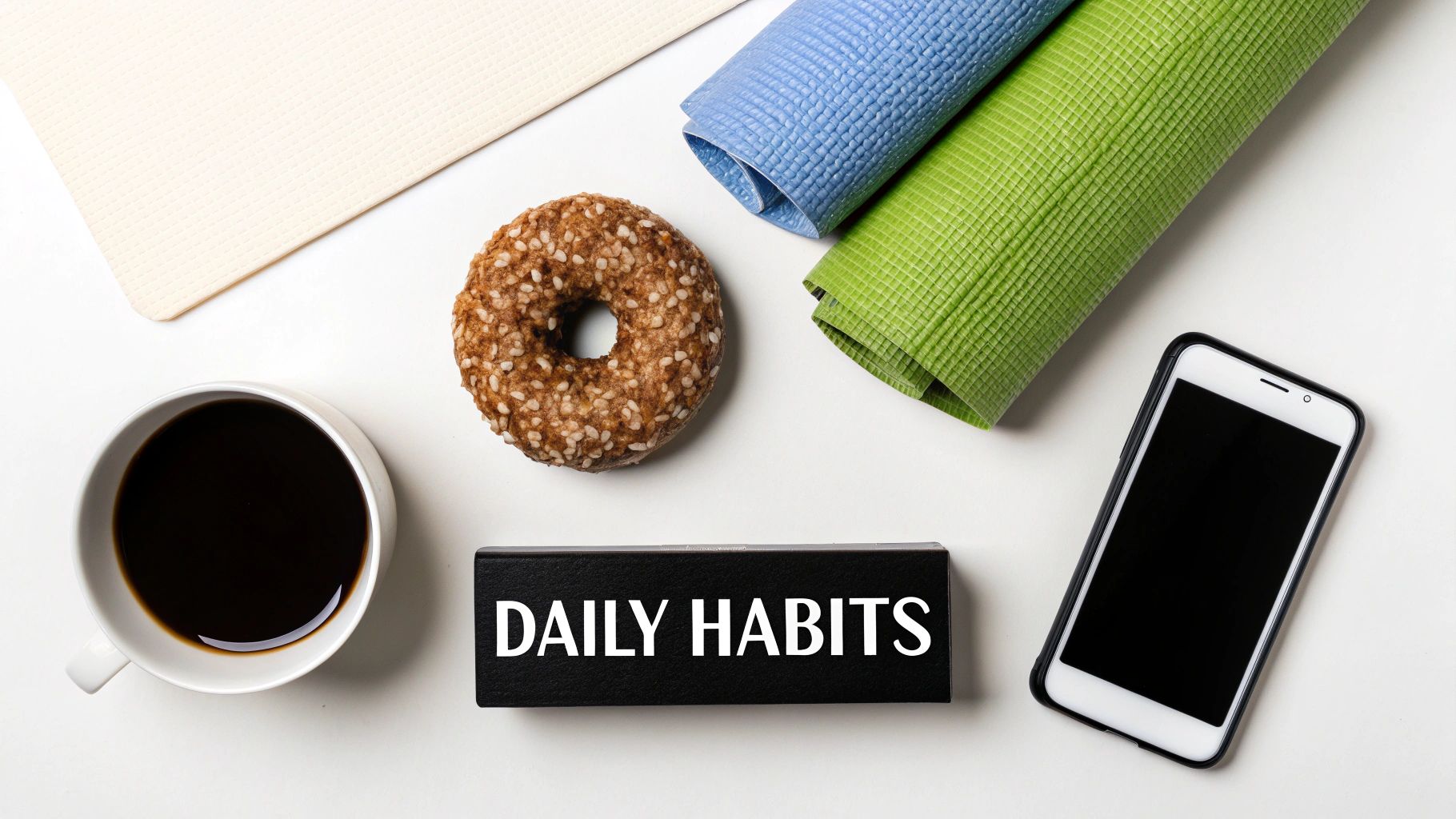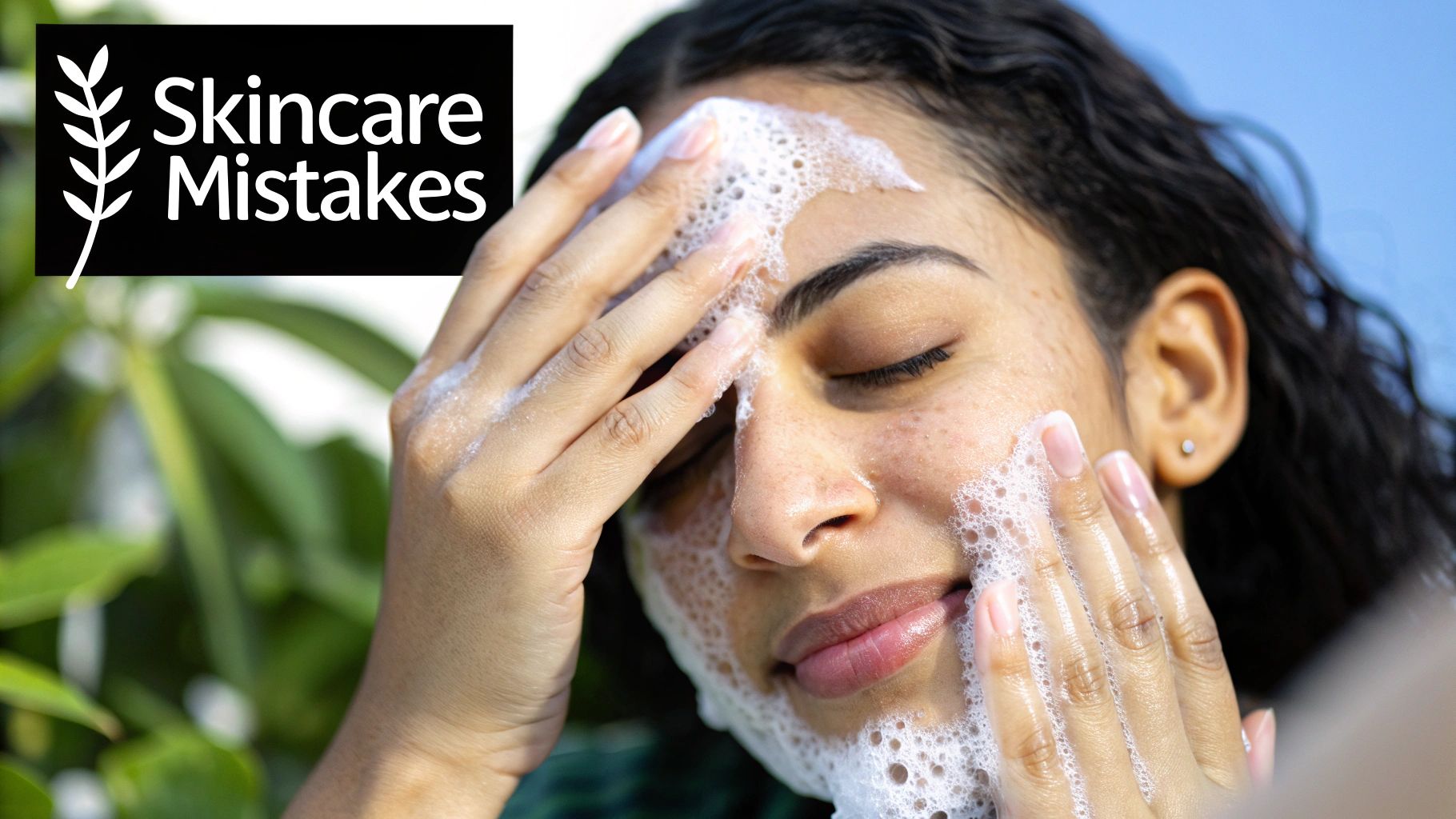What Causes Oily Skin and How to Manage It
- Web Dev
- Oct 20
- 13 min read
If you feel like you’re in a constant battle with shine, take a deep breath. You’re definitely not alone. The simple answer to what causes oily skin is that your sebaceous glands are a little overenthusiastic, producing more sebum (your skin’s natural oil) than you need. But why are they so active? It almost always comes down to a unique mix of your genetics, hormonal signals, and a few lifestyle factors.
Your Journey to Balanced Skin Starts Here
Consider this your first step towards truly understanding the story behind your skin's behaviour. We're going to move past the generic advice and dive into the real biological and lifestyle triggers at play. This isn't just about facts; it's about learning to listen to your skin and finally understand what it's trying to tell you.
My goal is to empower you with the knowledge to see your oily skin not as a flaw, but as a part of you that simply needs to be understood and nurtured. Getting to grips with these root causes is the real secret to unlocking a calmer, more balanced complexion and feeling fantastic in your own skin.
The Three Pillars of Oily Skin
When you peel back the layers, everything boils down to three core areas that work in tandem to decide just how much oil your skin produces. It's rarely just one culprit; think of it as a collaboration of influences that create your unique skin profile.
Practical Insight: Gaining this clarity is liberating. It allows you to shift from fighting against your skin to working with it, making informed choices that bring lasting balance instead of just a temporary fix.
This infographic gives a brilliant visual overview of how these primary causes are all connected.

The map clearly shows that while genetics might set the stage, it’s our hormones and daily habits that often take the leading role in turning up the volume on oil production. Let's start by exploring these main reasons for that excess shine:
Your Genetic Blueprint: You can often thank your parents for this one! A tendency for oily skin is frequently inherited. If they had oily skin, there’s a good chance you will too, as your genes dictate the size and activity level of your sebaceous glands.
Hormonal Fluctuations: Hormones, especially androgens, are like little messengers that can signal your glands to kick into high gear and produce more sebum. This is precisely why you might notice oiliness peaks during puberty, around your menstrual cycle, or during times of high stress.
Lifestyle and Environment: Don't underestimate the power of your daily habits and surroundings. Your diet, stress levels, skincare choices, and even the climate you live in can all throw your skin's natural equilibrium off-kilter and trigger more oil.
To make this even clearer, let's break down these interconnected factors into a simple table.
Quick Guide to Oily Skin Triggers
Here’s a snapshot of the primary internal and external factors that can lead to that familiar shine, helping you pinpoint what might be influencing your own skin.
Trigger Category | Primary Cause | Its Impact on Your Skin |
|---|---|---|
Genetics | Inherited traits | This determines the natural size and activity level of your sebaceous glands from birth. |
Hormones | Androgens (like testosterone) | These hormones directly signal your sebaceous glands to produce more oil. |
Lifestyle | Diet, stress, and skincare | High-glycaemic foods, cortisol (the stress hormone), and harsh products can all overstimulate oil production. |
Environment | Climate and pollution | High humidity can increase oiliness, while pollutants can clog pores and trigger inflammation. |
Understanding this interplay is your first step. By recognising how your genetics, hormones, and daily life intersect, you can start making targeted changes that truly make a difference.
The Science Behind the Shine

To really get to the heart of what causes oily skin, we need to look deeper than just the surface. It all starts with tiny, powerful structures in your skin called sebaceous glands. You have them almost everywhere, except for the palms of your hands and the soles of your feet.
Think of these glands as your skin’s own built-in moisturising system. Their primary job is to produce sebum—a clever mixture of oils and waxes that’s actually brilliant for you. Sebum creates a protective film, seals in hydration, and keeps your skin feeling soft and healthy.
The issue for those of us with oily skin is that this system is stuck in overdrive. When your glands produce too much sebum, you get that familiar shine, a greasy texture, and, quite often, clogged pores. To fully appreciate this, it helps to understand the fundamentals of cellular health, as this is the foundation for everything our skin does.
The Role of Hormones and Genetics
So, what's telling these glands to work so hard? The main culprits are our hormones, particularly a group known as androgens.
Androgens, such as testosterone, send direct signals to your sebaceous glands, telling them to produce more oil. This is exactly why your oiliness might flare up during puberty, pregnancy, or around your menstrual cycle—all times when your hormones are fluctuating wildly.
But hormones aren't the only factor at play. Your genetics provide the blueprint for your skin's natural tendencies. If your parents had oily skin, there’s a good chance you’ve inherited genes for larger or more active sebaceous glands, setting you up for higher oil production right from the start.
Practical Insight: Your skin isn't misbehaving; it's simply following its unique biological instructions. Understanding this science empowers you to respond with care and precision, rather than frustration.
All that extra sebum can easily mix with dead skin cells, creating the perfect recipe for a blocked pore. This is a key reason why enlarged pores are such a common frustration if you have an oilier complexion. We dive deeper into this connection in our guide on what causes enlarged pores.
The Link Between Oily Skin and Acne
It’s no coincidence that oily skin and breakouts often go hand in hand. When your pores get clogged with that mix of sebum and dead skin, it creates an oxygen-poor environment where acne-causing bacteria can flourish, leading to inflammation and spots.
This relationship is incredibly clear here in the UK, where acne affects so many people. Studies have found that a staggering 61.4% of acne patients also report having oily skin, showing just how significant a contributor it is. For many of us, getting sebum production under control is the first and most crucial step towards clearer, healthier-looking skin.
How Your Daily Habits Influence Your Skin

While your genes and hormones might set the stage, it’s your daily choices that truly direct the show. This is where your power lies. You can genuinely take the reins and turn down the dial on oil production with a few small but incredibly meaningful adjustments.
Think of your diet and stress levels as backstage managers for your sebaceous glands. When you eat certain foods or find yourself in a high-pressure situation, you’re basically sending memos to your skin. Sometimes, those memos say, "Full steam ahead on oil production!" The wonderful news? You get to decide what those memos say.
The Food and Shine Connection
What you put on your plate can have a direct conversation with your skin. Certain foods—especially those high in sugar, refined carbs, and for some people, dairy—can make your blood sugar soar. This spike sets off a hormonal chain reaction that can signal your oil glands to get to work.
This isn’t about demonising certain foods or chasing a 'perfect' diet. Not at all. It’s simply about understanding the connection and making conscious swaps that work for you.
High-Glycaemic Foods: Think sugary drinks, white bread, and processed snacks. These can fire up hormones that directly stimulate sebum production.
Dairy Products: For some, the hormones naturally present in milk products can be a trigger for extra oil and breakouts.
Mindful Swaps: Try bringing more whole grains, leafy greens, and lean proteins into your meals. These foods help stabilise your blood sugar, sending much calmer, more balanced signals to your skin.
This is about empowerment, not restriction. By paying attention to how your skin reacts to different foods, you can start building a way of eating that helps it find its own happy equilibrium.
How Stress Shows Up on Your Skin
Ever noticed you get a bit shinier during a frantic week at work? It’s not your imagination. When you’re stressed, your body pumps out more cortisol, the main stress hormone. And cortisol is yet another one of those messengers that can order your sebaceous glands to produce more oil.
Practical Insight: Managing stress isn't just good for your mind; it's a profound act of skincare. A few moments of calm each day can translate into a more balanced and less reactive complexion for you.
Finding your own way to decompress is a total game-changer. Whether it’s a quick walk outside, a few minutes of meditation, or just taking five deep breaths at your desk, these simple acts can lower your cortisol levels. In turn, they help regulate oil production. It's a beautiful reminder of how deeply our mental wellbeing is connected to our skin’s health.
While diet and stress are huge pieces of the puzzle, what you physically put on your skin matters just as much. To dive deeper, take a look at our guide on the skincare ingredients to avoid for healthier skin.
Uncovering Environmental Triggers for Oily Skin
Your skin is in a constant conversation with the world around you. Sometimes, that dialogue can get a little heated, leading to a surge in oil. While you can't exactly control the weather, understanding how your environment influences your skin is a massive step toward reclaiming balance. It’s all about becoming your skin’s best advocate, protecting it from the external stressors that send it into overdrive.
Think of it like this: your skin is always trying to maintain its perfect moisture level. When the air is thick with heat and humidity, your skin naturally sweats more, and that sweat can easily mix with your natural oils, or sebum. This combination is what makes your skin feel greasy and more prone to breakouts. It's a classic experience during a British summer heatwave or a holiday to a warmer climate.
The Climate Connection
The environment you find yourself in plays a huge role in how much oil your glands produce day-to-day. Both scorching heat and, surprisingly, the bitter cold can trick your skin into a state of imbalance, often leading to that frustrating, slick feeling.
It’s really just your skin’s defence mechanism kicking in. In hot, humid conditions, both your sweat glands and your oil glands can become more active, contributing to that surface shine. In fact, research has shown that sebum production can increase by 10% for every single 1°C rise in temperature. No wonder summer often brings on the extra shine.
Practical Insight: Your environment is constantly sending signals to your skin. The real secret is learning to interpret these signals and respond with protective, gentle care, rather than harsh reactions. That's how you achieve a lasting, healthy balance.
But what about the other extreme? It's a common myth that oily skin gets better in winter. Harsh winds and low humidity can actually strip your skin of its natural moisture, seriously compromising its protective barrier.
When Dry Air Deceives Your Skin
It’s not just the outdoors you need to think about. Indoor environments can be just as challenging. Central heating in the winter and blasting the air conditioning in the summer both create incredibly dry air, which can dehydrate the surface of your skin, even if it's oily deep down.
This is where things get interesting. That surface dehydration triggers a powerful response. Your skin, sensing it’s become far too dry, sends an emergency signal to your sebaceous glands: "We need more moisture, now!" And what happens? Your glands overcompensate, pumping out even more oil to make up for the dryness they're detecting. This is often called the rebound effect.
Stripped Barrier: Cold air and indoor heating weaken your skin’s natural lipid barrier, making it terrible at holding onto moisture.
Dehydration Signals: Your skin mistakes this surface dryness for a total lack of oil, kicking sebum production into high gear.
The Vicious Cycle: You might then reach for harsh, stripping products to combat the new oiliness, which only damages the barrier further and keeps the cycle going.
By understanding these environmental triggers, you can start making smarter choices for your skin. Something as simple as using a humidifier in dry conditions or switching to a slightly more nourishing (but still non-comedogenic!) moisturiser in winter can help protect your skin barrier. It’s all about preventing those panic signals that lead to that frustrating rebound shine.
Common Skincare Mistakes You Might Be Making

When you're trying your best to get that shine under control, it's incredibly easy to fall into a few well-intentioned traps. The irony? These common habits often end up making your skin even oilier. You might be working against your skin without even realising it.
The good news is that bringing these habits into the light is the first step toward real change. Once you know what to look for, you can make simple, powerful shifts. It’s all about moving from a mindset of "fighting" the oil to "balancing" it, creating a routine that gently coaxes your skin back to a place of calm, comfortable harmony.
The Myth of Aggressive Cleansing
By far, the biggest mistake people make is over-washing their face with harsh, stripping cleansers. When your face feels oily, the gut instinct is to scrub it until it’s squeaky clean. That tight, dry feeling seems like a victory, but it’s actually the exact opposite of what your skin needs.
That squeaky-clean sensation is a distress signal from your skin's protective barrier. When you strip away every last bit of its natural oil, this delicate shield is left compromised. Your skin, sensing it’s dehydrated and under attack, goes into panic mode. The response? It tells your sebaceous glands to ramp up oil production to compensate for the loss.
Practical Insight: Think of your skin barrier as a wise gatekeeper. When you treat it harshly, it overreacts to protect what's inside. Gentle, supportive care is the secret to helping it relax and find its natural equilibrium.
This isn't just a minor annoyance; it’s a widespread issue. In the UK, over a third of adults have struggled with acne, a condition often fuelled by excess oil. The NHS spent a staggering £22.67 million on topical acne treatments in a single year, which really drives home the need for smarter skincare. We need strategies that work with our skin, not against it. You can learn more about the broader impact from these revealing acne statistics.
Skipping Essential Hydration
Here’s another myth we need to bust: the idea that oily skin doesn't need moisturiser. I get it—it feels completely backwards to add moisture to skin that already feels slick. But skipping this step is another major trigger for that rebound shine we just talked about.
When your skin is dehydrated, it can't function properly. Even the oiliest of complexions can lack water, sending those same panic signals to your glands to produce more and more oil.
The secret is to choose the right kind of hydration. You’re not looking for heavy creams; you need something that gives your skin a drink of water without weighing it down.
Keep an eye out for moisturisers that are:
Lightweight: Think refreshing gels or water-based lotions that sink in beautifully.
Oil-Free: This ensures you’re not adding any extra oil to the mix.
Non-Comedogenic: This is a non-negotiable! It means the formula is specifically designed not to clog your pores.
By giving your skin the light, thirst-quenching moisture it craves, you send a signal that everything is balanced and protected. It’s a simple, consistent step that helps regulate sebum over time, leading to a complexion that feels hydrated, comfortable, and so much less greasy.
Your Action Plan for Balanced, Happy Skin
Alright, now that we’ve journeyed through the why behind oily skin, it’s time for the fun part: turning that understanding into real, lasting change. This isn't about waging a war on oil or chasing an unnaturally matte complexion with harsh, stripping products.
Think of it more like nurturing a delicate ecosystem. The goal is to gently guide your skin back to its happy place, supporting its natural barrier instead of attacking it. This simple shift in mindset is everything. It puts you back in the driver's seat, paving the way for a complexion that’s not just less shiny, but truly healthy from the inside out.
The Four Pillars of a Balanced Routine
Crafting a routine that actually works doesn’t have to feel like a complex chemistry experiment. It really boils down to four foundational pillars. Get these right, and you're well on your way to calmer, more predictable skin.
A Gentle Cleanser: This is your non-negotiable first step. Look for a mild, sulphate-free formula that cleanses away excess oil and daily grime without that tight, squeaky-clean feeling. A happy skin barrier is a balanced skin barrier, and this is where it all begins.
A Smart Exfoliant: Ingredients like salicylic acid are a game-changer for oily complexions. Because it’s a beta-hydroxy acid (BHA), it can dive deep into your pores, dissolving the gunk and dead skin cells that cause blockages and breakouts. It’s like a deep clean from within.
A Lightweight Moisturiser: It might feel counterintuitive, but hydration is your best friend. Opt for oil-free, non-comedogenic moisturisers—gel or light lotion textures are perfect. This sends a signal to your skin that it’s properly hydrated, so it can finally dial down its own frantic oil production.
Daily Sun Protection: Don't skip this. Ever. Sun exposure can dehydrate your skin and cause inflammation, which only makes your sebaceous glands work overtime. A broad-spectrum, non-comedogenic SPF of 30 or higher is your daily shield, protecting your skin from irritation and damage.
Putting It All Together
Your real superpower here is consistency. By sticking with these core pillars day in and day out, you create a stable, supportive environment where your skin can finally find its equilibrium.
While this framework is a fantastic starting point for anyone with oily skin, those of us with combination skin sometimes need a more nuanced approach. If that’s you, our guide on the best skincare routine for combination skin might just be the extra bit of insight you need.
Practical Insight: Think of your skincare routine as a daily ritual of self-care, not a battle against your skin. When you choose products that nurture and respect its health, you're building a foundation for a calmer, more balanced complexion for years to come.
If you’re looking to take your care to the next level, professional treatments like a Jet Peel Facial can offer incredible deep cleansing and revitalisation, really helping to get oil production under control.
Just remember, this is a journey of progress, not a race to perfection. Be patient, listen to your skin, and celebrate the small wins along the way. You’ve got this.
Your Questions, Answered
Figuring out what makes oily skin tick is a process, and it's completely normal to have a few questions pop up. Let's walk through some of the most common ones together, giving you the clarity and confidence you need to move forward.
Will My Oily Skin Ever Settle Down as I Get Older?
For many people, the answer is a reassuring 'yes'. As we age, our hormone levels naturally begin to shift, and with that, sebum production often slows down.
That said, because genetics play such a huge part in your skin's story, you might always lean towards a more luminous complexion. The good news is, even if you do, it will likely become much more manageable over time.
Can Drinking More Water Really Help?
Staying properly hydrated is one of the best things you can do for your overall skin health, without a doubt. But will it magically turn off your oil-producing glands? Not exactly.
Think of it this way: when your skin is dehydrated, it can panic and produce even more oil to compensate. This is often called the rebound effect. Drinking enough water helps prevent this dehydration cycle, but it won't override the oiliness driven by your hormones or genes.
Are Mattifying Products a Good Long-Term Fix?
Mattifying products are absolutely brilliant for managing shine day-to-day. They’re a fantastic tool to have in your makeup bag or skincare arsenal for immediate results.
Practical Insight: It’s helpful to see them as a cosmetic touch-up, not a deep treatment. True, lasting balance comes from a consistent skincare routine that nurtures your skin barrier and helps regulate oil at its source.
Ready to build a routine that truly understands and supports your skin? At YOUTHFUL REVIVAL, we specialise in creating personalised skincare plans that help you glow with confidence. Discover our expert treatments and bespoke advice at https://www.youthfulrevival.com.

Comments